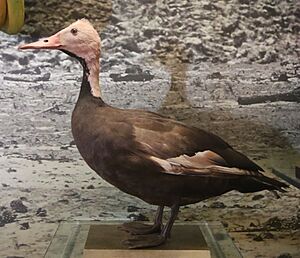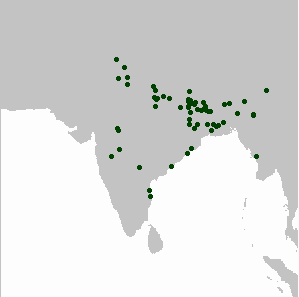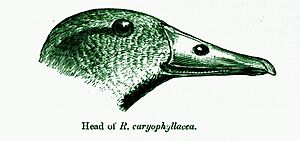Pink-headed duck facts for kids
Quick facts for kids Pink-headed duck |
|
|---|---|
 |
|
| Mounted specimen at National Museum of Scotland | |
| Conservation status | |
| Scientific classification | |
| Genus: |
Rhodonessa
|
| Species: |
caryophyllacea
|
 |
|
| Distribution of records of this species | |
| Synonyms | |
|
Anas caryophyllacea |
|
The pink-headed duck (Rhodonessa caryophyllacea) is a large diving duck. It used to live in parts of India, Bangladesh, and Myanmar. Sadly, it has been feared extinct since the 1950s. Many searches have been done, but no one has found proof it still exists.
Some people think it might still live in hard-to-reach swamp areas of northern Myanmar. A few reports from that region have led to its status being changed. It is now listed as "Critically Endangered" instead of extinct. This duck is special because of its pink head and dark body. It also has a bright white patch on its wings.
Contents
What Does the Pink-Headed Duck Look Like?
The male pink-headed duck is easy to spot if you get a good look. Both male and female ducks are about 41–43 centimeters (16-17 inches) long. They have long bills, long necks, and heads that come to a peak.
The male has a bright pink bill, head, and neck. The female has a lighter pinkish head and neck, with a paler bill. A thin black stripe runs down the front of their neck from their body. Their wings have a white edge that shows when they fly.
Young pink-headed ducks had heads that were almost white, with no pink color. People believed they made a soft, two-note call that sounded like wugh-ah.
Where Did the Pink-Headed Duck Live?
This duck lived in lowland marshes and ponds. These areas were often found in tall-grass jungles. They built their nests among the tall grasses.
The pink-headed duck laid six or seven eggs in a clutch. Their eggs were very round and creamy white. Each egg was about 4.3 to 4.6 centimeters (1.7 to 1.8 inches) long. They were thought to stay in one place and not migrate. They were usually seen alone or in pairs, rarely in small groups.
The main areas where they lived were north of the Ganges River in India. This included parts of Bihar. They were also found in Bangladesh and Myanmar. Some records show them in other places like Delhi and Punjab. This suggests they might have moved around locally during different seasons.
How Do Scientists Classify This Duck?
The pink-headed duck was first described by John Latham in 1790. He placed it in the Anas genus. Later, a special genus called Rhodonessa was created just for this duck.
Scientists have debated where this duck fits in the duck family. Some thought it was similar to the red-crested pochard (Netta rufina). Others believed it was so unique it needed its own genus. Its pink color comes from a special pigment called carotenoid. This is rare among ducks.
One interesting detail is its unique voice box (syrinx) in males. It has a special swelling at the base of the windpipe. This feature is not common in other ducks. The duck's large, almost spherical eggs are also very unusual. These unique features support keeping it in its own genus.
What is the Pink-Headed Duck's Status?
This duck used to live in eastern India, Bangladesh, and northern Myanmar. Now, it is likely extinct. It was always a rare bird. The last confirmed sighting was in June 1935 in India. Reports from India continued until the early 1960s.
In 1988, an American birdwatcher named Rory Nugent claimed to see the duck. He reported spotting it in India, but his sighting was not widely accepted. Since the 1960s, there have been other reports from northern Myanmar. This area is not well explored by scientists. However, searches there have not found the duck. People sometimes confuse it with other ducks like the red-crested pochard.
In 2017, an expedition tried to find the duck but failed. They found that the area's natural environment was getting worse. Local people in Myanmar have shared stories about seeing the duck more recently. Some said they saw it as late as 2010 or 2014. One hunter even claimed to have caught two ducks in 1998.
The main reason for its disappearance is probably the destruction of its habitat. Hunters also sought after the pink-headed duck. They wanted it for its unusual feathers. It was not considered good to eat, which might have helped any remaining birds survive. The last known ducks in captivity lived in aviaries in France and England. The only known photographs of the species were taken there around 1925.






